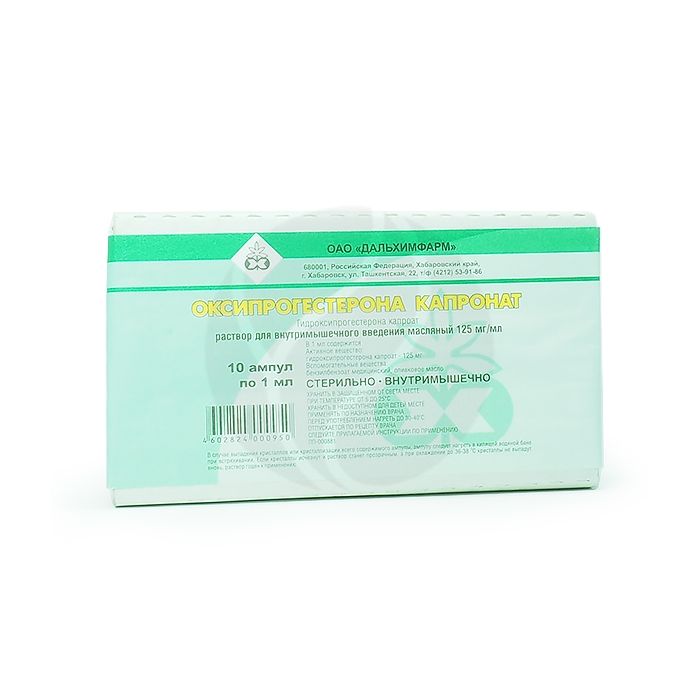Oxyprogesterone capronate solution for injection 12.5%, 1ml No. 10
Russian Pharmacy name:
Оксипрогестерона капронат раствор д/инъекций 12.5%, 1мл №10
Conditions associated with insufficiency of the corpus luteum:
amenorrhea (primary and secondary);
dysfunctional uterine bleeding.
Route of administration: intramuscularly. Before administration, the drug must be heated to 30-40 ? C. With amenorrhea (primary, secondary), it is prescribed immediately after the termination of the use of estrogenic drugs, 250 mg once or in two administrations.
For the treatment of dysfunctional uterine bleeding, the drug is less convenient than progesterone, because its effect is slow, but it can be used to normalize the cycle 62.5-125 mg (0.5-1 ml) on the 20-22 day of the cycle.
Solution for intramuscular injection, oily, light yellow or golden yellow, transparent.
1 ml
hydroxyprogesterone caproate 125 mg
Excipients: medical benzyl benzoate - 300 ?l, olive oil - up to 1 ml.
Hepatitis;
liver failure;
breast and genital cancer;
tendency to thrombosis;
children under 15 years old,
second half of pregnancy;
hypersensitivity to the components of the drug.
With care: for diseases of the cardiovascular system, arterial hypertension, chronic renal failure, diabetes mellitus, bronchial asthma, epilepsy, migraine, depression; hyperlipoproteinemia.
Treatment is often combined with estrogen therapy or immediately following estrogen therapy.
pharmachologic effect
A synthetic analogue of the corpus luteum hormone (progesterone). It differs chemically from progesterone in that at position 17 it contains a caproic acid residue. Being an ester of hydroxyprogesterone, it is metabolized more slowly than progesterone (it has a more lasting effect). After a single intramuscular injection of the oil solution, its effect lasts from 7 to 14 days. In terms of biological properties, it is similar to progesterone. By binding to receptors on the surface of cells of target organs, it penetrates into the nucleus, where, by regulating DNA transcription, it affects RNA synthesis. Promotes the transition of the uterine mucosa from the proliferation phase, caused by follicle-stimulating hormone, into the secretory one, and after fertilization creates the necessary conditions for the implantation and development of a fertilized egg.Reduces the excitability and contractility of the muscles of the uterus and fallopian tubes, stimulates the development of the alveoli (milk-forming parts) of the mammary glands
Pharmacokinetics
It is rapidly and almost completely absorbed after intramuscular administration.
It is metabolized in the liver to form conjugates with glucuronic and sulfuric acids.
T1 / 2 is 5 minutes. It is excreted by the kidneys - 50-60%, with bile - more than 10%. The amount of metabolites excreted by the kidneys varies depending on the phase of the corpus luteum
Indications of the drug Oxyprogesterone Capronate
Conditions associated with insufficiency of the corpus luteum:
amenorrhea (primary and secondary);
dysfunctional uterine bleeding.
Side effect
From the nervous system: drowsiness, headache, depression, apathy, dysphoria.
From the digestive system: cholestatic hepatitis, nausea, vomiting, loss of appetite, calculous cholecystitis.
From the genitourinary system: decreased libido, menstrual irregularities.
From the senses: visual impairment.
From the side of the cardiovascular system: increased blood pressure, peripheral edema, thromboembolism (including pulmonary artery and cerebral vessels), thrombophlebitis, retinal vein thrombosis.
From the endocrine system: galactorrhea, alopecia, weight gain, breast enlargement, pain and tension, hirsutism.
Allergic reactions.
Local reactions: soreness at the injection site.
Application during pregnancy and lactation
The drug is not used during pregnancy. In case of pregnancy on the background of the use of the drug, it is necessary to immediately interrupt the treatment; there is no data on the need for termination of pregnancy. The drug is contraindicated in the second half of pregnancy and during breastfeeding.
Application for violations of liver function
Contraindicated in liver failure and hepatitis.
Application for impaired renal function
With caution in chronic renal failure.
Application in children
Contraindicated in children under 15 years of age.
special instructions
In case of precipitation of crystals or crystallization of the entire contents of the ampoule, the ampoule should be heated in a boiling water bath with shaking. If the crystals disappear and the solution becomes transparent, and when cooled to 36-38 ? C, the crystals will not fall out again, the solution is suitable for use.
The prescription of the drug should be made only by the attending physician, under his supervision after an accurate diagnosis.
When treating amenorrhea in children, it is necessary, first of all, to verify the diagnosis of amenorrhea.
Treatment prior to puberty should be directed at stimulating growth. After 15-17 years, you can carry out replacement therapy with estrogens and gestagens, which causes cyclical uterine bleeding!
Influence on the ability to drive vehicles, mechanisms
Care should be taken when driving vehicles and engaging in other potentially hazardous activities that require increased concentration of attention and speed of psychomotor reactions, since the drug can cause side effects that may affect these abilities.
Overdose
Symptoms: depression of the central nervous system, drowsiness, tachycardia; increased blood pressure, weakness, sweating.
Treatment: discontinuation of therapy until the symptoms disappear, followed by the appointment of smaller doses. If necessary, symptomatic treatment is carried out.
Drug interactions
Weakens the effect of drugs that stimulate the contraction of the myometrium (oxytocin), anabolic steroids (nandrolone), pituitary gonadotropic hormones.
Strengthens the effect of diuretics, antihypertensive drugs, immunosuppressants, bromocriptine.
Reduces the effectiveness of anticoagulants.
The gestagenic activity of the drug is reduced by inducers of microsomal oxidation (barbiturates, hydantoins, rifshpicin, etc.).

